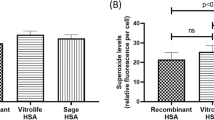Abstract
Human proteins normally used to supplement human in vitro fertilization—embryo transfer (IVF-ET) culture media were tested for their effects on mouse embryo development from the zygote stage. These proteins included follicular and luteal-phase maternal sera, fetal cord sera, and both human and bovine serum albumin. Our results revealed that both maternal and fetal cord sera did not permit mouse blastocyst formation. Furthermore, predialysis of the human maternal sera and removal of IgG by protein A column chromatography did not improve their support of mouse embryonic development to the blastocyst stage. Similar detrimental effects were observed with maternal sera from term-pregnant IVF-ET patients. Interestingly, these serum samples had supported the in vitro growth of the human zygotes which resulted in these patients' pregnancies. Only some batches of human serum albumin supported mouse blastocyst formation, whereas all sources of bovine serum albumin were effective in this regard. These results raise the question of the suitability of the mouse embryo culture system as a quality control for the testing of protein supplements for human IVF-ET.
Similar content being viewed by others
References
Cheung SW, Strickler RC, Yang VC, de Vera M, Spitznagal EL: A mouse embryo culture system for quality control testing of human in vitro fertilization and embryo transfer media and fetal cord sera. Gamete Research 1985;11:411–419
Davidson A, Vermesh M, Lobo RA, Paulson RJ: Mouse embryo cultures as a quality control for human in vitro fertilization: The one-cell versus two-cell model. Fertil Steril 1988;49:516–521
Quinn P, Warnes GM, Kerin JF, Kirby C: Culture factors in relation to the success of human in vitro fertilization and embryo transfer. Fertil Steril 1984;41(2):202–209
Biggers JD: Pioneering mammalian embryo culture.In The Mammalian Preimplantation Embryo: Regulation of Growth and Differentiation in vitro, 1st ed., Bavister BD (ed). New York, Plenum Press, 1987, pp 1–22
Kruger TF, Stander FSH, Smith K, Van der Merwe JP, Lombard CJ: The effect of serum supplementation on the cleavage of human embryos. J Vitro Fert Embryo Transfer 1987;4:10–12
Ogawa T, Marrs RP: The effect of protein supplementation on single-cell mouse embryos in vitro. Fertil Steril 1987;47(1):156–161
Saito H, Berger T, Mishell DR Jr, Marrs RP: The effect of serum fractions on embryo growth. Fertil Steril 1984;41(5):761–765
Shirley B, Wortham JWD Jr, Witmyer J, Condon-Mahony M, Fort G: Effects of human serum and plasma on development of mouse embryos in culture media. Fertil Steril 1985;43(1):129–134
Haimovici F, Hill JA, Anderson D: Variables affecting toxicity of human sera in mouse embryo cultures. J Vitro Fert Embryo Transfer 1988;5:202–206
Naz RK, Janousek JT, Moody T, Stillman RJ: Factors influencing murine embryo bioassay: Effects of proteins, aging of medium, and surgical glove coatings. Fertil Steril 1986;46:914–919
Shirley B, Wortham E Jr, Peoples D, White E, Condon-Mahony M: Inhibition of embryo development by some maternal sera. J Vitro Fert Embryo Transfer 1987;4:93–97
Oksenberg JR, Brautbar C: In vitro suppression of murine blastocysts growth by sera from women with reproductive disorders. Am J Reprod Immunol 1986;11:118–124
Damewood MD, Hesla JS, Schlaff WD, Hubbard M, Gearhart JD, Rock JA: Effect of serum from patients with minimal to mild endometriosis on mouse embryo development in vitro. Fertil Steril 1990;54(5):917–920
Caro CM, Trounson A: The effect of protein on preimplantation mouse embryo development in vitro. J Vitro Fert Embryo Transfer 1984;1:183–187
Ogawa T, Ono T, Marrs RP: The effect of serum fractions on single-cell mouse embryos in vitro. J Vitro Fert Embryo Transfer 1987;4:153–158
Hogan B, Costantini F, Lacy E: Manipulating the Mouse Embryo, A Laboratory Manual, 1st ed. Cold Spring Harbor, NY, Cold Spring Harbor Laboratory, 1986
Laemmli UK: Cleavage of structural proteins during the assembly of the head of bacteriophage T4. Nature 1970;227:680–685
Wray W, Boulikas T, Wray VP, Hancock R: Silver staining of proteins in polyacrylamide gels. Anal Biochem 1981;118:197–203
Findley WE, Hutchens TW: Partial characterization of the toxicity of human serum used for in vitro fertilization (IVF) as evaluated in mouse embryo cultures. Fertil Steril 1990;S93–S94
Quinn P, Kerin JF, Warnes GM: Improved pregnancy rate in human in vitro fertilization with the use of a medium based on the composition of human tubal fluid. Fertil Steril 1985;44:493–498
Mehta TS, Kiessling AA: Development potential of mouse embryos conceived in vitro and cultured in ethylenediamine tetraacetic acid with or without amino acids or serum. Biol Reprod 1990;43:600–606
Schultz GA: Utilization of genetic information in the preimplantation mouse embryo.In Experimental Approaches to Mammalian Embryonic Development, Rossant J, Pederson RA (ed). Cambridge, Cambridge University Press, 1986, pp 239–265
Telford NA, Watson AJ, Schultz GA: Transition from maternal to embryonic control in early mammalian development: A comparison of several species. Mol Reprod Devel 1990;26:190–200
Braude P, Bolton V, Moore S: Human gene expression first occurs between the four- and eight-cell stages of preimplantation development. Nature 1988;332:459–461
Ziomek CA: Cell polarity in the preimplantation mouse embryo.In The Mammalian Preimplantation Embryo: Regulation of Growth and Differentiation in Vitro, Bavister BD (ed). New York, Plenum Press, 1987 pp 23–41
Wiley LM, Kidder GM, Watson AJ: Cell polarity and development of the first epithelium. BioEssays 1990;12:67–73
Author information
Authors and Affiliations
Rights and permissions
About this article
Cite this article
Léveillé, MC., Carnegie, J. & Tanphaichitr, N. Effects of human sera and human serum albumin on mouse embryo culture. J Assist Reprod Genet 9, 45–52 (1992). https://doi.org/10.1007/BF01204114
Received:
Accepted:
Issue Date:
DOI: https://doi.org/10.1007/BF01204114




